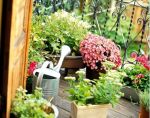
April is here and it is certainly living up to it’s reputation with beautiful sun shine one minute and showers the next. After all the dry weather over the past couple of months the rain is well needed, even a day or so of rain has made my veg patch go crazy. Every morning I get excited by something new starting to poke it’s head out of the soil.
It’s all going off in the veggie patch this month with plenty of seed sowing to be done. When sowing seeds a good tactic to have is to sow little and often, this will give you a constant supply of produce and hopefully avoid getting a glut reaching maturity at once. Sow things like lettuce, beetroot, broad beans, salad onions, turnips and salad leaves at intervals of seven to ten days to achieve a succession crop.
Winter brassicas – Although it may feel that we have only just left winter we should already be thinking about broccoli, cabbage, cauliflower and Brussels sprouts for next. So outside now in a prepared seed bed. Those sow last month may be ready for transplanting, they should be moved to a permanent bed before the plants get too large. The ideal time for transplanting is when they have two to three true leaves, don’t forget to water in.
Watering – Although we are having April showers now if we do have a dry patch don’t forget to water plants well. All young vegetable plants need water to develop well. It is far better to water lots occasionally then water a little frequently.
Thinning out – If seedlings are not thinned out the plants will become straggly and not crop well. Thinning out means removing seedlings to allow the plants left to reach full maturity and size potential. The thinnings of most vegetables, except root vegetables such as carrots, beetroots and turnips, can be transplanted. Water seedlings before and after thinning in dry weather.
Herbs – Garden centres and market stalls are now bursting at the seams with plants so it’s an ideal time to stock up on herbs. I love buying unusual varieties and there are some fantastic ones out there. This weekend I brought some amazing smelling mints such as grapefruit and black beauty, also some gorgeous thymes and sages. You can never have too many herbs; they look great, smell amazing and are pretty tasty too!
Runner beans – Having grown mine on the window sill now is the time to plant them out. Runner beans need a strong and tall structure to scramble on such as an obelisk, arch or up a wall. From past experience I have found that is much easier to have your support ready and in place before the beans start growing too much! An obelisk is easy to make and can be made out of anything such as bamboo, willow, cornus, hazel or any old poles or curtain rails you have lying around the garden or house. If you haven’t already grown some runner bean seedling then it’s not too late to plant a couple of seeds at the bottom of each pole.
April is a great month in the veggie patch as we are beginning to see the fruits of our labour, not quite harvesting them yet, but it won’t be long now!












































